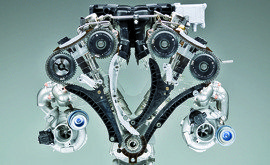
 Second Drive
Second Drive


Johann Kistler, project manager for the BMW 7-series, calls the new V-12 in the 760Li the “icing on the cake” in BMW’s engine portfolio. That must be some cake.
As for the icing, the new 6.0-liter V-12 follows BMW’s latest method of turbocharging and direct fuel injection to boost power while keeping fuel-economy ratings in check. With 535 horsepower and 550 pound-feet of torque (increases of 97 and 106, respectively, over the previous 7-series’ naturally aspirated V-12), its acceleration should be on par with the mighty M3’s. A 6.6-liter version of this engine with slightly more power (563 horses, 575 pound-feet) will appear in the upcoming Rolls-Royce Ghost sedan and later in the whole Rolls lineup.
The 760Li comes with BMW’s first transmission with eight gears, made by ZF. BMW claims that the automatic can drop directly from eighth gear down to second under heavy throttle; the best we managed was seventh to third. In sport and manual modes, the transmission starts in first gear; otherwise, second is used to pull away from a stop. Acceleration is hardly slower with the second-gear start, if at all—we’ll have to wait until we get a car to run numbers on.
The long-wheelbase-only 760Li sets itself apart in price—a staggering $54,245 more than the 400-hp, twin-turbo V-8 750Li—but for the money, you get heated and cooled front and rear seats as standard equipment, along with a heated steering wheel, soft-close doors, a 16-speaker stereo, and lots more. Aside from that, the 760Li is largely identical to the 750Li. BMW calls attention to the presence of extra cylinders with V-12 badges on the side vents, a larger double-kidney grille, and four ports to the chrome exhaust tips instead of two.
In terms of price and power, the 760Li sits between two twin-turbo V-12s from Mercedes: the 510-hp S600 and the 604-hp S65 AMG. The BMW engine is smoother in its application than either Benz. Acceleration feels utterly linear in contrast to the rubber-band suddenness of the Benzes. Rear-seat passengers will prefer the more serene nature of the Bimmer. And if our most recent comparison test of V-8 versions of the S-class and 7-series is any indication, front-seat occupants will prefer the 760Li as well.
______________________________________
BMW’s N74 V-12


Unlike BMW’s nontraditional, twin-turbo V-8, which positions its turbos inside the vee, the new V-12 (code-named N74) has a Honeywell MGT22 turbo sitting outside each of the two cylinder banks, feeding in a relatively modest 11.6 psi of boost. The twin intercoolers run on a separate coolant circuit from the engine, circulated by an electric pump. The fuel injectors, working at pressures as high as 2900 psi, can fire up to five pulses per injection cycle. It sounds excessive, considering the minuscule window for fuel injection, but BMW says this improves combustion. The bore spacing matches the outgoing V-12’s, though, and the engine is essentially two inline-sixes joined in a 60-degree vee. So the cylinder heads are both new (to the V-12) and old (taken from BMW’s familiar 3-liter, twin-turbo inline-six).